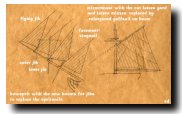
jibs - mizzen gaff
In the early century, the bowsprit was extended by a jib-boom
to accommodate the triangular jibs attached to the stays.
The mast for the sprit-topsail and the spritsail below the bowsprit were
then removed, although the yard(s) below the bowsprit were retained to
give the bowsprit and attached rigging rigidity. By the end of the century,
another boom was attached to the end of jib-boom, carrying the flying
jib.
The lateen mizzen, which had survived almost unchanged from the 14th
Century, was now cut and the portion extending in front of the
mizzenmast removed, making it effectively a gaffsail.
Although the "surplus" portion of the mizzen yard was retained in larger
ships, also it was removed after the mid-century and replaced by a
gaff that was attached directly to the back of the mizzenmast.
The horizontal boom (derived from the 17th Century Dutch
yacht) was introduced for bending the gaffsail foot. The long boom
extended beyond the stern of the ship and the sail grew in size
accordingly. In some ships also a triangular gaff-topsail was
added above the gaff.

full-rigged frigate
At the end of the century, as the royal sail was introduced also on
the mizzen mast (along with the new skysail in fore- and main
masts), mainly in frigates (in this case both the warship
and the ship type...) sporting large amounts of canvas, the
full-rigged ship (a sailing ship with at least three
masts, and all of them rigged with at least three square sails) was
born. Generally, the (sailing ship) terms were differentiated so that
a "frigate" was a warship and a "full-rigged ship" meant a
merchantman.
Whereas earlier the flag signals used by fleets had been rather
simple predetermined combinations of single flags raised to
a particular mast-top
(RN 1775 Sailing and Fighting Instructions),
the year 1800 signalling system of the British Navy was based on
11 differently patterned flags that,
when raised in a certain order, could be combined to spell out words
or a wide range of special, predetermined orders. The modern-day
flag signals were derived from these Royal Navy origins.
The effectiveness of naval gunnery continued to increase: the
British made improvements in gunnery technology which helped to
increase the rate of fire and introduced the heavy carronade gun for
devastating close combat effect.
(Cannon
and Carronades)
The classification of the warships was updated as the number of
guns increased:
Ships-of-the-line (S.O.L.):
- 1st Rate - Ships with 100-130 guns
Three-deckers, senior admiral flagships
- 2nd Rate - Ships with 90-98 guns
Three-deckers, junior admiral & foreign station flagships
- 3rd Rate -
Ships with 80 guns; powerful two-deckers
Ships with 74 guns; two-decker "workhorses" of
battle fleets, the most numerous type of S.O.L.s
Ships with 64 guns; two-deckers, which were,
however, being phased out by the end of the era, the smallest type
of S.O.L.s in numbers
Non-S.O.L.s:
- 4th Rate - Ships with 44-50 guns
Both single- and two-deckers, "razees" (two-decker S.O.L.s with
the upper deck cut off, offering a sturdy hull and good armament,
but retaining the dull sailing qualities of the original) or
purpose-built heavy-armed frigates
- 5th Rate - Ships with 32-40 guns
The single-decked "standard" frigate
- 6th Rate - Ships with less than 32 guns
Smaller ships were used for courier or escort duties: sloops,
two-masted brigs, with the gaff-sail, "brigsail" attached
to the mainmast, gunboats etc.
(Rating of
Warships - bottom of page)
The English 1st class S.O.L. Victory was launched in 1765 and
stayed in active service until 1812, serving, among other commitments,
as Admiral Nelson's flagship during the Battle of Trafalgar in 1805.
The US Frigate Constitution (1794) was one of the US Navy
"super frigates" that were rated at 38 to 44 guns but had almost two
full gun decks with more cannon, and it had an extraordinarily sturdy
live oak planking on the sides, thus earning the nickname "Old
Ironsides". In fact, in 1813 the British Admiralty issued an order
for the RN frigates not to engage the US Navy frigates unless they had
the enemy outnumbered at least 2 to 1...
(HMS Victory website)
(USS Constitution official website)
Only 17 years after the Battle of Trafalgar, the Royal Navy
commissioned the steam-engined paddle-wheel warship Comet
to its ranks, thus signalling the upcoming change in the naval warfare,
and 50 years after the battle the sailing warship was removed from the
seas for good.
The sailing merchantmen, meanwhile, continued to thrive and
were used, albeit in constantly diminishing numbers, well into the 20th
Century.
